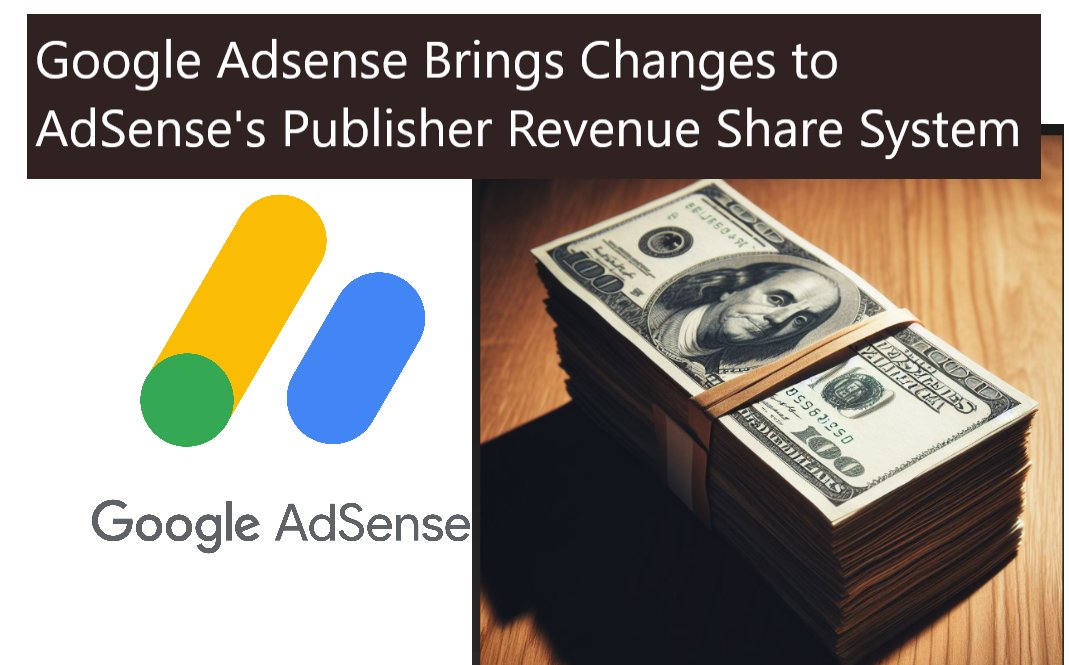Google Adsense Brings Changes to AdSense’s Publisher Revenue Share System That Will Take Effect in 2024

Google Adsense Brings Changes to AdSense’s Publisher Revenue Share System
Google AdSense has long been one of the most popular advertising networks used by publishers and content creators to monetize their websites and earn revenues through display advertising. The program allows publishers to show Google ads on their site, and earn a share of the revenue generated when visitors view or click on these ads.
AdSense has generally operated under a cost-per-click (CPC) payment model, where publishers earn money when a visitor engages with an ad by clicking on it. However, Google recently announced that it will be making significant changes to how publishers earn from AdSense, including switching to a cost-per-impression (CPM) payment model and updating the underlying revenue share structure.
These changes, slated to take effect in early 2024, will have major implications on publisher revenues. While Google claims that earnings should remain largely the same for most publishers, initial reactions within the publisher community have been mixed. Some anticipate potential benefits, while others have raised concerns about possible downsides of prioritizing impressions over clicks.
Key Changes Announced by Google
The most significant change announced by Google is that AdSense will transition from primarily paying publishers on a per click basis, to paying per impression. This means publishers will earn money every time an ad is displayed on their site, regardless of whether visitors click on it.
Google says this shift to CPM billing brings AdSense in line with the wider display advertising industry standard for valuing ad inventory. The company argues it provides a more uniform and consistent way for publishers to be compensated across ads served via Google or other ad tech platforms.
Additionally, Google is updating the underlying revenue share structure. Previously, Google deducted fees and paid publishers from one single transaction. Now, the AdSense revenue will be split into separate buy-side and sell-side rates.
On the buy side, Google Ads will take a cut of around 15% on the advertiser spend. Of the remaining 85% on the AdSense side, publishers will receive 80%, while Google retains 20%. So Google claims that with both sides put together, the overall revenue share for publishers will remain around 68% – the same as before.
The policy changes are being framed as bringing more transparency into Google’s cuts, rather than drastically impacting publisher payments. However, the devil is often in the details with such changes, and the practical impact remains to be seen when implemented.
Reaction from Publishers
Within the online publisher community, the initial reaction to Google’s announced changes has been somewhat mixed. Some publishers see potential benefits, while others have raised concerns about possible downsides.
On WebmasterWorld forums and discussions, some publishers welcomed the switch to CPM billing. They noted how under a click-based model they sometimes suffered from low-CTR ads that generated no revenue despite consuming page resources. A CPM approach could provide more predictable earning for ad space.
However, other publishers voiced skepticism, and suspected the changes were primarily designed to benefit Google over publishers. Some raised concerns that by de-emphasizing clicks and actions, the changes could inadvertently incentivize publishers to overload pages with ads just to generate impressions. This could diminish content quality, user experience, and advertiser ROI over the long run.
Analysis of Potential Impact
There are reasonable arguments to be made both for and against the potential impact of Google’s new AdSense payment policies on publishers.
On the positive side, the shift to CPM billing could provide more stability and predictability in revenues for publishers. Currently, publishers earn nothing from low performing ads that don’t generate clicks, regardless of how much traffic they drive to those ads. Even well-targeted ads sometimes fail to engage users and produce clicks.
Under a CPM model, publishers will earn something for every impression, proportional to the value Google and advertisers place on that ad space and audience segment. This should make revenues more stable and predictable, and reduce the variance seen under CPC billing.
The change may also level the playing field for different forms of display inventory. Some ad formats like page skins, large banners or video ads intrinsically have lower click-through rates. Publishers were previously disadvantaged running these units through AdSense versus other networks optimized for CPM billing.
However, there are also risks to over-emphasizing impressions over user engagement. Critics argue that the changes could negatively impact content quality over the long run. Currently, publishers are incentivized to create compelling content and optimize user experience to drive clicks on ads.
But under the new model, some may shift focus toward maximizing impressions through clickbait headlines, shocking images or cramming pages with ads at the expense of user experience. If taken too far, this could annoy users, damage a publisher’s brand, and reduce the value of their audience to advertisers over time.
There are also concerns about how advertisers will respond if the CPM billing model reduces user clicks and conversions. Even if publishers earn steady revenues from impressions, advertisers may pull back spend if the ads become less effective at driving desired actions.
Much depends on the specific CPM rates AdSense pays per impression. If set too low, publishers may still feel compelled to overload on ads. Google will need to strike the right balance for a sustainable ecosystem.
Key Factors that Will Determine the Impact
Looking ahead, there are a few key factors that will ultimately determine whether Google’s new AdSense model benefits publishers or not:
– The specific CPM rates that Google establishes per impression. Higher rates obviously provide more revenue for publishers.
– Whether Google actively adjusts these CPM rates to keep overall publisher revenue largely the same. Google has implied they will normalize revenues.
– How publishers optimize under a CPM model. Will they overload pages with ads, or focus more on quality engagement?
– How advertisers respond in terms of ROI and spend as clicks potentially decrease. Lower advertiser demand could offset revenues.
– The extent to which Google tracks changes in publisher revenues and engagement data, making further optimizations to minimize negative impacts.
The devil is in the details when it comes to balancing CPM billing models between publishers, advertisers and ad networks. Small tweaks to rates and incentives can shift behaviors over the long run.
Google will be hoping it has found the right balance with its new model. But the company will likely need to keep optimizing the system as all players involved adapt to the changes over time.
Best Practices for Publishers
Assuming the CPM model does translate into reduced engagement and clicks, publishers should take proactive steps to adapt while still maintaining quality:
– Focus on producing compelling content and optimizing user experience – don’t take shortcuts to simply maximize impressions. High-value audience and engagement is still key.
– Carefully test different ad placement configurations. Look for a good balance between revenue potential and experience. Don’t overcrowd pages.
– Actively monitor changes in both earnings and user engagement with ads as the new model rolls out. Check for excessive declines.
– Be prepared to adjust ad layouts and placements if engagement drops substantially. Consider shifting some high-performing units back to CPC billing.
– Evaluate opportunities for more native ad formats that blend with content rather than disrupt. User perception ofads still impacts responses.
– Diversify revenue streams. Don’t become over-reliant on AdSense. Consider affiliate programs, memberships, paid products or services.
The CPM shift likely won’t change web publisher business models overnight. But prudent publishers should take steps to preserve quality, engagement and diversity of revenues. This will allow them to prosper regardless of changes in Google’s incentives.
Conclusion
Google’s upcoming shift to a CPM billing model for AdSense publishers represents a major change, albeit one common in the wider online ad industry. The actual impact on publishers remains uncertain.
There are potential benefits in terms of more predictable revenues, reduced variance and a level playing field. But there are also risks if taken too far. Over-emphasizing impressions could hurt content quality, user experience and advertiser ROI over the long run.
The ultimate impact will depend on the execution details, especially the CPM rates. Google will need to dynamically optimize the new model as publishers and advertisers respond. There may also be a period of instability as all players adapt.
Publishers should monitor earnings and engagement closely as changes roll out in 2024. They may need to tweak ad configurations and diversify income streams if clicks significantly decline under the new model. With the right balance, CPM billing could improve revenues. But publishers will need to be proactive about preserving quality and engagement.
